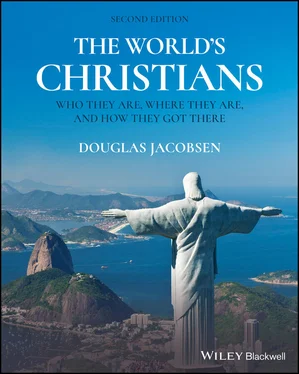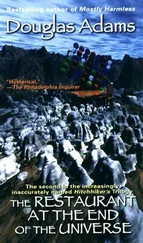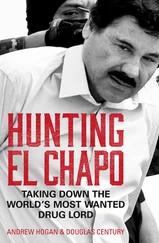Pentecostalism is a young movement and its history is short, but that history is also complex and far from fully understood. It is now clear that Pentecostalism had many sites of origin. One of the birthplaces of Pentecostalism was the Mukti Mission in Pune, India where Pandita Ramabai, an internationally known Hindu feminist convert to Christianity, oversaw a Pentecostal‐like religious revival during the years 1906 and 1907. Around the same time, Isaiah Shembe was forming his new independent amaNazaretha church in South Africa that was both anticolonial and decidedly charismatic in orientation. Willis Hoover began preaching a Spirit‐centered message within the Methodist Church of Chile during these same years, and comparable events took place in Europe and East Asia. Unlike the other three Christian mega‐traditions, Pentecostalism has been multicentered and global from the very beginning.
The Azusa Street Revival that began in Los Angeles in 1906 gathered up all the various global expressions of spiritual fervor and turned them into a self‐conscious Pentecostal movement. The meetings at the Azusa Street Mission were directed by an African American preacher named William J. Seymour (introduced in Voices of World Christianity 4.1 ). He was an unassuming leader who, rather than preach, would sometimes just sit in the front of the meeting and pray in silence, and miracles would occur. News of the revival quickly spread around the world. People came from everywhere to see what was going on, and the result was the creation of a network of Spirit‐filled Christians who saw themselves as part of a new people of God being called into existence.
Ever since the Azusa Street Revival, the Pentecostal movement has been growing the same way that it started, by word of mouth, by serendipitous encounter, and by men and women who go wherever in the world they feel God is leading them to spread the Pentecostal message. Much of the movement’s growth has taken place outside the recordkeeping cultures of western society, and Pentecostalism has tended to flourish among the poor and illiterate rather than among the rich and powerful. Accordingly, its growth was initially overlooked, and its history has been under‐documented. In most of the world, the Pentecostal movement of the twentieth century was like a forest fire burning underground and out of sight. It was only in the 1960s with the rise of the Charismatic Movement that Pentecostalism began to break into mainstream culture and to receive academic attention. During the last half century Pentecostalism has much more visibly exploded around the world.

Figure 4.5 International Church of the Grace of God, located on a pedestrian shopping street in downtown Buenos Aires, Argentina. Founded in 1980, the International Church of the Grace of God is a Pentecostal denomination with more than 2,000 congregations in Latin America.
Photo by author.
Large Pentecostal churches now exist in many different parts of the world (see Figure 4.5). In the 1990s, the movement was growing so fast that some scholars were predicting that the Pentecostal movement would convert all of Latin America within twenty‐five years, replacing Catholicism as the region’s dominant faith. That did not happen, and the trend lines of Pentecostal growth now seem to be leveling out in many regions. Still, it is unlikely that Pentecostalism has reached its peak. A hundred years ago, there were only a handful of Pentecostals in the world. Today there are almost half a billion. However the movement is assessed, no one can doubt that the emergence and growth of Pentecostalism is one of the most dramatic developments in all of Christian history.
SUGGESTIONS FOR FURTHER READING
1 Alexander, Paul (2009). Signs and Wonders: Why Pentecostalism is the World’s Fastest Growing Faith. San Francisco: Jossey‐Bass.
2 Anderson, Alan (2004). An Introduction to Pentecostalism. Cambridge: Cambridge University Press.
3 Burgess, Stanley M., and Eduard M. Van Der Mass (eds.) (2002). International Dictionary of Pentecostal and Charismatic Movements, revised and expanded. Grand Rapids, MI: Zondervan.
4 Christerson, Brad, and Richard Flory (2017). The Rise of Network Christianity: How Independent Leaders Are Changing the Religious Landscape. Oxford: Oxford University Press.
5 Cox, Harvey (1995). Fire from Heaven: The Rise of Pentecostal Spirituality and the Reshaping of Religion in the Twenty‐First Century. New York: Addison‐Wesley.
6 Hollenweger, Walter J. (1997). Pentecostalism: Origins and Developments Worldwide. Peabody, MA: Hendrickson.
7 Jacobsen, Douglas (2003). Thinking in the Spirit: Theologies of the Early Pentecostal Movement. Bloomington: Indiana University Press.
8 Kay, William K. (2009). Pentecostalism. London: SCM.
9 Robeck, Cecil M., and Amos Yong (eds.) (2014). The Cambridge Companion to Pentecostalism. Cambridge: Cambridge University Press.
10 Wacker, Grant (2003). Heaven Below: Early Pentecostals and American Culture. Cambridge, MA: Harvard University Press.
1 1William H. Durham, “Personal Testimony of Pastor Durham,” Pentecostal Testimony, 1(3), 7 (undated but likely 1909).
2 2D. Wesley Myland, The Latter Rain Covenant and Pentecostal Power with Testimony of Healings and Baptism (Chicago: Evangel Publishing House, 1910), pp. 25–6.
PART II How They Got There: A Global History of Christianity
Introduction
Christianity began as a small religious movement in the Middle East, and it now encircles the world. No other religion has ever attracted so many followers in so many different places. The next four chapters tell the story of how this happened. These same chapters also explain how Christianity’s beliefs and practices have changed and developed over the centuries. Before launching into that long and fascinating Christian history, however, it is important to look at Christianity’s pre‐history. Christianity did not spring into existence fully formed. It began as a small religious movement within Judaism, and deciding if and how Christianity might remain connected with Judaism was one of the thorniest issues the new movement would faced.
Christianity’s Pre‐History and Relationship with Judaism
Many of the core beliefs and practices of Christianity derive from Judaism. Judaism itself has a complex history, and its origins cannot be described in detail because the historical record is so thin. The Bible tells a vivid story of exodus from Egypt and conquest of Palestine, but the archaeological record reflects a slower and less dramatic process that eventually gave birth to Israel and to Jewish religious consciousness. It is clear that by about 1000 BCE an Israelite kingdom had been established in Palestine with religious life focused on rituals performed at the Temple in Jerusalem.
This early form of Judaism confronted a tremendous challenge when Palestine was conquered by the powerful Babylonian emperor Nebuchadnezzar II in the year 587 BCE. The Jewish Temple was destroyed, and many Israelites were deported to Persia. Without a temple, Jews began developing other practices to preserve their faith. The single most important innovation was the synagogue , a place where Jews could gather to worship God, teach their children, and discuss religious and moral matters. In many different synagogues scattered throughout the Middle East, Jews hashed out their faith and debated their differences. When disputes arose and conflicts of interpretation had to be settled, Jews turned to another new institution, local religious courts known as sanhedrins , for decisions. These institutions continued to shape Jewish faith and life after Jews returned to Palestine (starting around 540 BCE) and even after a second Temple was built and Temple worship resumed around 520 BCE.
Читать дальше













